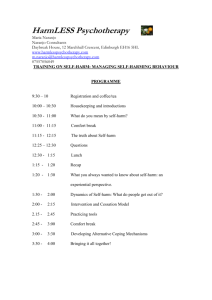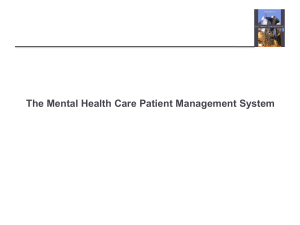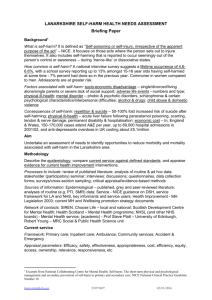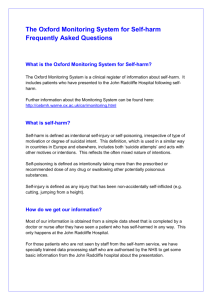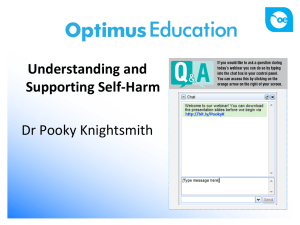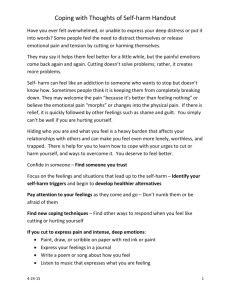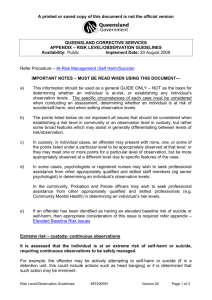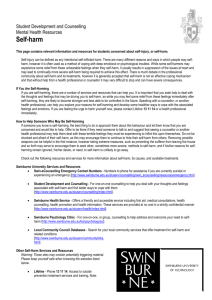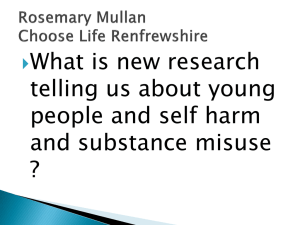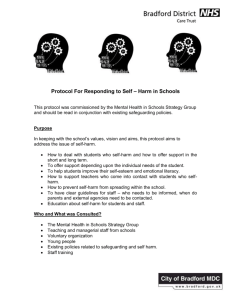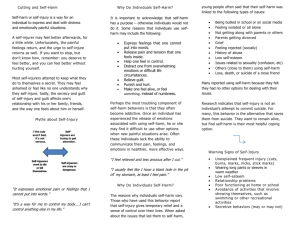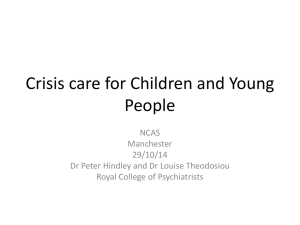Self Harm Teacher Parent Resource 2014
advertisement
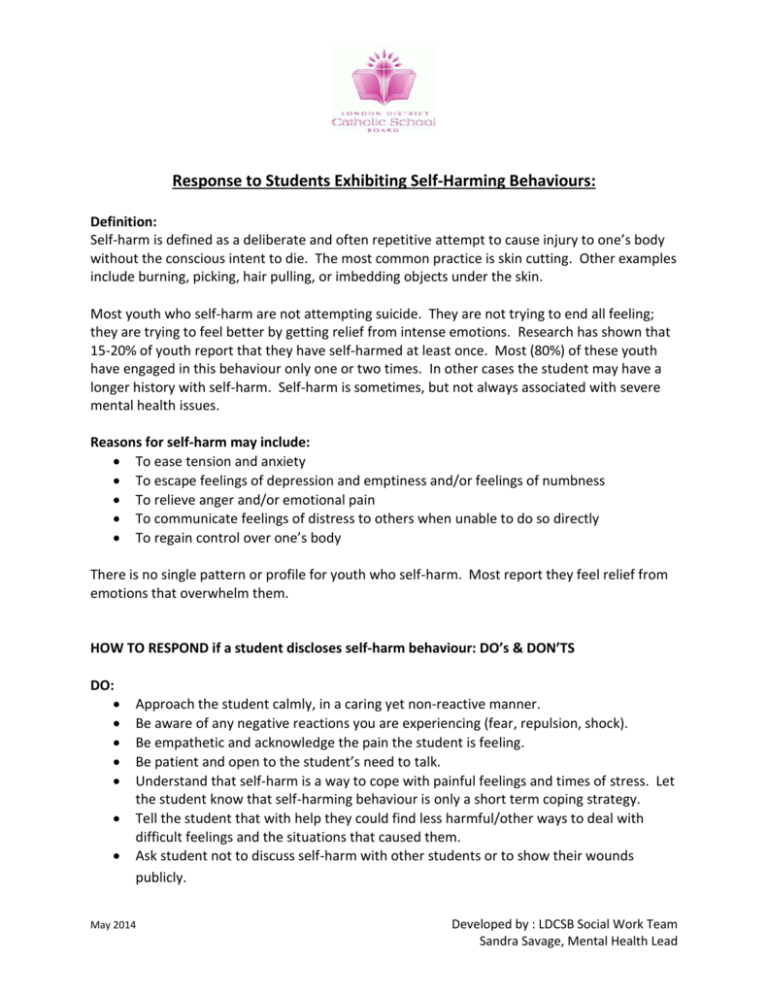
Response to Students Exhibiting Self-Harming Behaviours: Definition: Self-harm is defined as a deliberate and often repetitive attempt to cause injury to one’s body without the conscious intent to die. The most common practice is skin cutting. Other examples include burning, picking, hair pulling, or imbedding objects under the skin. Most youth who self-harm are not attempting suicide. They are not trying to end all feeling; they are trying to feel better by getting relief from intense emotions. Research has shown that 15-20% of youth report that they have self-harmed at least once. Most (80%) of these youth have engaged in this behaviour only one or two times. In other cases the student may have a longer history with self-harm. Self-harm is sometimes, but not always associated with severe mental health issues. Reasons for self-harm may include: To ease tension and anxiety To escape feelings of depression and emptiness and/or feelings of numbness To relieve anger and/or emotional pain To communicate feelings of distress to others when unable to do so directly To regain control over one’s body There is no single pattern or profile for youth who self-harm. Most report they feel relief from emotions that overwhelm them. HOW TO RESPOND if a student discloses self-harm behaviour: DO’s & DON’TS DO: Approach the student calmly, in a caring yet non-reactive manner. Be aware of any negative reactions you are experiencing (fear, repulsion, shock). Be empathetic and acknowledge the pain the student is feeling. Be patient and open to the student’s need to talk. Understand that self-harm is a way to cope with painful feelings and times of stress. Let the student know that self-harming behaviour is only a short term coping strategy. Tell the student that with help they could find less harmful/other ways to deal with difficult feelings and the situations that caused them. Ask student not to discuss self-harm with other students or to show their wounds publicly. May 2014 Developed by : LDCSB Social Work Team Sandra Savage, Mental Health Lead Ask student to cover their wounds to reduce public exhibition of scars. Explain that vulnerable peers may be triggered by seeing them. (Note: Healed wounds should not be covered with bandages). Self-harm is best discussed individually. Talk to friends/groups separately. (Note: This is different than suicide prevention which can be discussed openly in public). Identify safe adults the student can go to at school or in the community. Offer, but don’t insist to help the student get connected with a professional who can help them learn safer/alternative coping strategies. ***Seek medical intervention if there are ANY concerns that the wound is more than superficial (i.e. calmly state that we would like the student to be seen medically)*** DON’T: Do not assume it is an indication of suicidal intent. Do not judge/criticize or insist on behaviour stopping. Do not respond with intense emotion. Do not ask “Why would you do that?” Do not make promises of secrecy. Do not arrange for groups of friends, class or school wide discussions and/or assemblies (to reduce risk of the contagion effect). Do not minimize self-harm by saying it is a fad or a phase. Do not immediately state that the student needs help. Do not expect the behaviour to change quickly. For Children UNDER 14 (elementary): School staff to notify Principal, Vice-Principal, or Teacher Responsible. They in turn MUST notify parent(s). This is not a crisis situation unless the student discloses suicidal thoughts. If the student discloses suicidal thoughts follow the suicide protocol (Safe Schools: Section Z). For Youth 14 AND OVER (secondary): School staff to notify Guidance and/or consult the school social worker. Guidance or Social Worker in turn MAY notify parent(s)/guardian(s). This is not a crisis situation unless the student discloses suicidal thoughts. If the student discloses suicidal thoughts follow the suicide protocol (Safe Schools: Section Z). Your School Social Worker can be a resource to you for a non-crisis situation/referral. Please consult to determine if the student is an appropriate referral. May 2014 Developed by : LDCSB Social Work Team Sandra Savage, Mental Health Lead TIPS for Talking to Parents: Speak calmly in a non-reactive manner and identify concerns (use the words self-harm and not the words cut, slashed, etc.) Identify if medical treatment is needed right away or not (i.e. cuts require stitches) While the behaviour is concerning and we want to address it, most often it does not indicate suicidal intent. Most often we find youth choose self-harm as a way to cope with stress and/or distress. Plan a timely (vs. urgent) meeting with the parents to go over ways to support student to cope with stress/distress at school and/or with home life. If a number of students are involved in self-harm inform parents that each student will be met with individually to address concerns as research indicates we want to avoid a contagion effect. Ask the parent if they would like you to send information home re: self-harm in a sealed envelope. If parents still seem very concerned and worried, recommend they make an appointment with their family doctor. ADDITIONAL RESOURCES/READINGS: Supporting Minds: Chapter 8: Self Harm and Suicide: http://www.edu.gov.on.ca/eng/document/reports/SupportingMinds.pdf mindyourmind: http://www.mindyourmind.ca Kids Help Phone: http://www.kidshelpphone.ca The ABC’s of Mental Health: http://www.hincksdellcrest.org/ABC/Welcome Self-Injury Outreach & Support: University of Guelph/McGill University Collaborative: http://www.sioutreach.org/learn/school-professionals May 2014 Developed by : LDCSB Social Work Team Sandra Savage, Mental Health Lead
